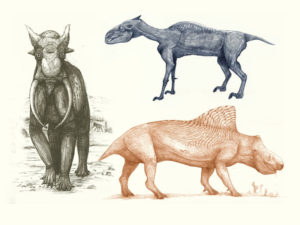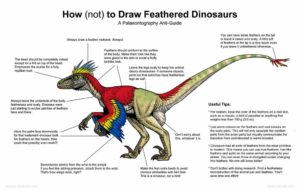Sep
20
What Did Dinosaurs REALLY Look Like?
A “paleoartist” is someone who creates original art that is supposed to visually represent prehistoric life. Ever wonder how paleoartists know what dinosaurs and such looked like?

Well, it begins with various bits of scientific evidence — primarily from the size and structure of the skeleton — that inform the illustrations. This has improved over the decades with the discovery of more and better fossils. But, beyond that it is largely speculation. It has also been suggested that there is a circular effect of speculation making its way into popular culture depictions (e.g., Jurassic Park/World movies), which then reinforce assumptions made in later paleontological reconstructions and paleoartistic illustrations. In other words, it’s as much art as it is science, and we are surely getting a few things wrong.
Paleoartist C.M. Koseman published an illustrated book about the subject a few years ago (All Yesterdays: Unique and Speculative Views of Dinosaurs and Other Prehistoric Animals (2012)) with fellow-paleoartist John Conway and paleozoologist Darren Naish.
“[John and I] were both dinosaur geeks, but the more we looked at these skeletons, and the more we looked at the pictures, we noticed that most mainstream dinosaur art didn’t look at dinosaurs as real creatures.” (Koseman)
For one thing, as summarized by Eric Grundhauser in his 2017 article,
“Our world is full of unique animals that have squat fatty bodies, with all kinds of soft tissue features that are unlikely to have survived in fossils, such as pouches, wattles, or skin flaps…. In many ways, there is a certain amount of uniformity in the way we think of dinosaurs, which creates some common tropes in paleoart that Kosemen thinks could improve.”
Take dinosaur heads, for example. Dinosaur art generally shows them as crocodile-like, with little-to-no lips, gums, or facial fat to speak of. Since the fleshy parts disintegrate over time, we don’t really know what distinguishing facial features they may have given prehistoric creatures. All we see are teeth. (Similar issue with other parts of the body, of course.)
Another example is “roadkill hair”. As per Grundhauser,
“Some fossils show signs of hair, which Kosemen says can lead to artists illustrating their creatures with hair only on the parts where it was found on a fossil. However, it’s possible that some dinosaurs had much more hair than they are usually shown to have.”

Yet another trope involves the recent popularity of feathering dinosaurs.
“While it is a good way to add some color and flair to an illustration, the placement and length of dinosaur feathers is often based more in fantasy than any past reality. [Kosemen] thinks that sometimes dinosaurs are over-feathered, with plumage where it doesn’t belong, or under-feathered, being too conservative with the overall coverage.”
A related issue is “feather dressing”. This is when a paleoartist takes the “color palette” of a living bird’s feathers and simply transplants it onto a dinosaur. “There’s no way in the world that a specific bird’s clothing would be replicated in a dinosaur in the past.” (I doubt that’s provable, but it is a fair point.)
Finally, Koseman points to the matter of proportion and the tendency to exaggerate the heads and claws.
“Artists sometimes do this semi-unconsciously because they want to depict the head and the claws, the business end of the thing.”
So, what can be done? Not much, it seems.
Paleoartists work with what they have. As per Grundhauser,
“It’s likely that far-future paleoartists will have similar problems with creatures we take for granted today. [They will also] continue dreaming up the endless variations of the prehistoric animal world, by taking a cue from the creatures in our own backyards.”
But, Koseman gives the following advice to up-n-coming paleoartists:
“Do not imitate them, but see what other shapes they could take.”
Meanwhile, the public likes its dinosaurs big and/or scary-looking (i.e., “cool”), which helps maintain interest, which in turn helps generate funding for future research.















